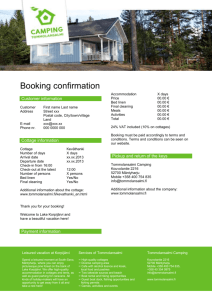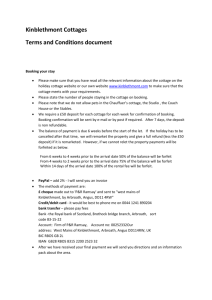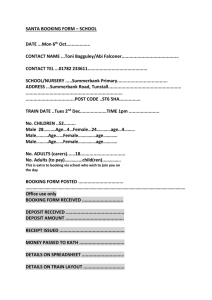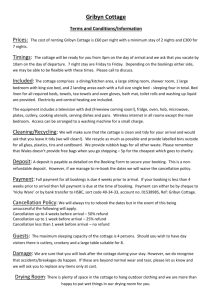TIES 437 (2015): Guidelines for the Task 2
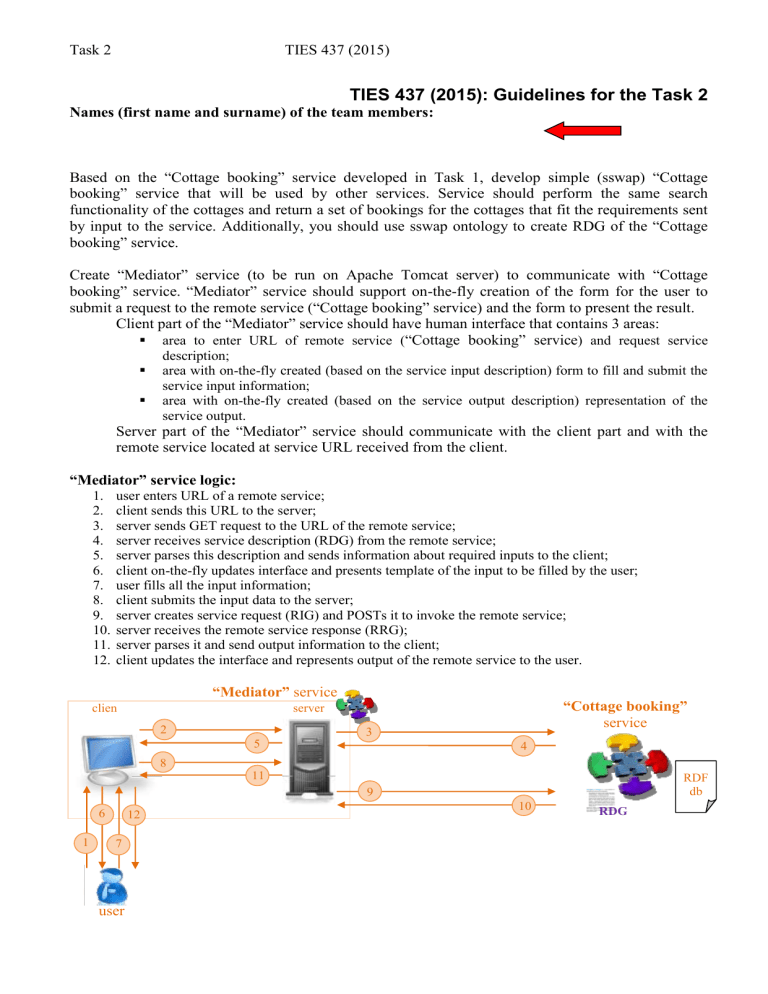
Task 2 TIES 437 (2015)
TIES 437 (2015): Guidelines for the Task 2
Names (first name and surname) of the team members:
Based on the “Cottage booking” service developed in Task 1, develop simple (sswap) “Cottage booking” service that will be used by other services. Service should perform the same search functionality of the cottages and return a set of bookings for the cottages that fit the requirements sent by input to the service. Additionally, you should use sswap ontology to create RDG of the “Cottage booking” service.
Create “Mediator” service (to be run on Apache Tomcat server) to communicate with “Cottage booking” service. “Mediator” service should support on-the-fly creation of the form for the user to submit a request to the remote service (“Cottage booking” service) and the form to present the result.
Client part of the “Mediator” service should have human interface that contains 3 areas:
area to enter URL of remote service (
“Cottage booking” service
) and request service description;
area with on-the-fly created (based on the service input description) form to fill and submit the service input information;
area with on-the-fly created (based on the service output description) representation of the service output.
Server part of the “Mediator” service should communicate with the client part and with the remote service located at service URL received from the client.
“Mediator” service logic:
1.
user enters URL of a remote service;
2.
client sends this URL to the server;
3.
server sends GET request to the URL of the remote service;
4.
server receives service description (RDG) from the remote service;
5.
server parses this description and sends information about required inputs to the client;
6.
client on-the-fly updates interface and presents template of the input to be filled by the user;
7.
user fills all the input information;
8.
client submits the input data to the server;
9.
server creates service request (RIG) and POSTs it to invoke the remote service;
10.
server receives the remote service response (RRG);
11.
server parses it and send output information to the client;
12.
client updates the interface and represents output of the remote service to the user.
“Mediator” service clien t
2
5 server
3
4
“Cottage booking” service
8
11
RDF
9 db
6 12
10
11
RDG
1 7 user
Task 2 TIES 437 (2015)
To support transformation of the “Cottage booking” service developed in Task 1 into a sswap
“Cottage booking” service, you might need to extend previously created domain ontology(ies) or create some extra ontology(ies):
each group makes own ontology(ies);
ontology(ies) should be located inside .war
package of the service;
be sure that URI(s) of ontology(ies) points to the real location (e.g. localhost:8080/exampleService/onto/exampleOntology.owl);
Please notice that concepts used for cottage description and concepts that describe search request/response might not be the same.
Result:
Provide the result of this Task as an archive of the following files:
this document;
OWL file(s) with domain ontology(ies);
RDF file in Turtle (n3) notation with data about the cottages (Cottage database);
RDF file in Turtle (n3) notation with “Cottage booking” service description (RDG);
WAR file and source code of the “Cottage booking” service;
WAR file and source code of the “Mediator” service.
Send the Task result to lecturer (oleksiy . khriyenko @ jyu . fi) before the deadline.
Result will be presented by the group during the next Demo-Lecture.
!!! Please, send RDF files in Turtle (n3) notation with “Cottage booking” service RDG, RIG and RRG, as well as corresponding Ontology(ies) by
01.04.2015.
